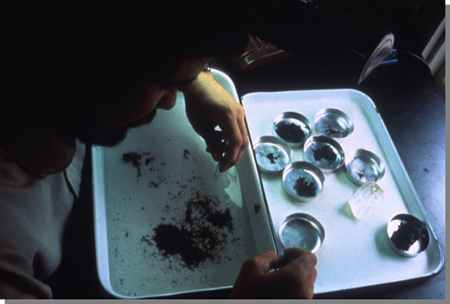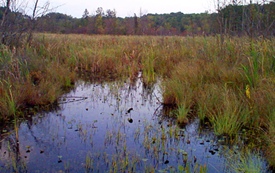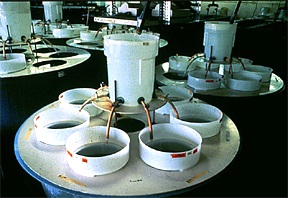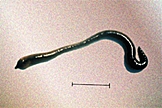Ecological Risk Assessment Step 4
Sections of Step 4 Baseline ERA (BERA) Study Design and Data Quality Objectives Process:
In Step 4, the Baseline Ecological Risk Assessment Study Design and Data Quality Objectives Process, the measurement endpoints are selected and the Conceptual Site Model (CSM) is completed. In addition, the study design, including statistics, is done for the site study that will accompany site-specific studies for the cleanup investigation. The CSM is used to identify which points or assumptions in the risk assessment include the greatest degree of conservatism or uncertainty. Step 4 should result in the production of a Workplan (WP) and Sampling and Analysis Plan (SAP).
Work Plan & Sampling Analysis Plan
The purpose of the Workplan (WP) is to document the decisions and evaluations made during the previous steps and to identify additional investigative tasks needed to complete the study of risks to ecological resources. It generally includes and describes:
- A general overview and background of the site including the site's physical setting, ecology, and previous uses;
- The identification of additional site investigations needed to conduct the ecological risk assessment;
- The general scope of any additional sampling activities;
- A summary and analysis of previous site investigations and conclusions;
- Assessment endpoints;
- Exposure pathways, including a conceptual site model;
- Questions and testable hypotheses;
- Measurement endpoints and their relation to assessment endpoints;
- Uncertainties and assumptions.
The Sampling and Analysis Plan (SAP) typically consists of two components: a Field Sampling Plan (FSP) and a Quality Assurance Project Plan (QAPP). The SAP describes:
- Data needs;
- How the study is done, including sampling techniques and data analysis procedures;
- Data interpretation techniques, including statistical analyses;
- Quality assurance procedures and quality control techniques.
The Field Sampling Plan (FSP) provides a detailed description of the samples needed to meet the objectives and scope of the investigation outlined in the WP. It should include a description of the following:
- Sampling type and objectives;
- Sampling location, timing, and frequency;
- Sample designation;
- Sampling equipment and procedures;
- Sampling handling and analysis.
The Quality Assurance Project Plan (QAPP) provides a description of the policies, organization, practical activities, and quality control procedures necessary for achieving the study's objectives. Quality control procedures are goals, plans, and guidelines that are spelled out to insure a high level of quality in the collection and analysis of the data and the handling of samples.
Selection of Assessment Endpoints
Definition: A Measurement Endpoint is "a measurable ecological characteristic that is related to the valued characteristic chosen as the assessment endpoint and is a measure of biological effects (e.g., death, reproduction, growth) of particular species, and can include measures of exposure as well as measures of effects. The following criteria should be considering when selecting measurement endpoints:
- The relationship between measurement and assessment endpoints must be clearly described within the model and must be based on scientific evidence.
- A measurement endpoint should be relevant to the assessment endpoint it represents; for example, the use of daphnia (water fleas) toxicity would not be appropriate for a Contaminant of Potential Ecological Concern (COPEC) that affects kidneys, since water fleas are invertebrates that do not have kidneys.
- How well can the possible measurement endpoints answer questions about the assessment endpoints or the site model? If it is not feasible to collect the necessary data (such as for studies of population changes over time), that measurement endpoint should probably not be used.
- Statistical power and sample size;
- Species/community/habitat characteristics;
- The sensitivity to the COPECs;
- Mechanisms of ecotoxicity
Species/Community/Habitat Considerations
Measurement endpoints should include risks to, and be representative of, all of the species, populations, or groups included in the assessment endpoint(s) that is/are being investigated in terms of those particular measurement endpoints.
In selecting a measurement endpoint, the species and life-stage (young, juvenile, adult), population, or community chosen should be the one(s) most likely to be affected by the contaminant in question. For species and populations, the selection should be based on which routes of exposure are likely and also based on the particular species' life history, behavioral, and physiological attributes. For communities, consideration of contaminant fate and transport is important.
Study Design
Evidence can be gathered from literature sources or in situ or laboratory toxicity testing. Sometimes more than one line of evidence is needed to reasonably show that contaminants from a site are likely to cause adverse effects on the assessment endpoint(s). This is because in some cases a Contaminant of Potential Ecological Concern (COPEC) might exceed screening values, but its effects are limited because the plants or animals do not easily take up the contaminant.
-
There are three general types of studies that are generally done:
- bioaccumulation and tissue residue field studies,
- population/community evaluations, and
- toxicity testing.
Samples should be taken from locations with contaminated media (soil, sediment, water) and from reference sites. Reference data might be data that had been collected from the site before the contamination occurred or new data collected from a reference site.
Bioaccumulation Studies:
Bioaccumulation and tissue residue field studies typically are conducted at sites where contaminants are likely to accumulate in food chains. The studies help to determine contaminant exposure levels associated with measures of effect for assessment endpoint species. It is recommended that species selected for these studies consider the following:
- Ability to accumulate the Contaminant of Potential Ecological Concern (COPEC);
- Home range;
- Population size (for particular species, it is preferable to have plants and animals of similar ages and sizes);
- Size of the animals/composites (it is better to have individual plants and animals large enough for chemical analysis rather than pooling data from more than one plant or animal).
Plants and/or small organisms may be exposed to contaminants either when eating contaminated food or while in contact with contaminated materials. These plants and small animals may take up that contamination into their own bodies and can pass the contaminants on to the larger organisms that eat them. This is referred to as bioaccumulation through a food chain. Caged fish or mussel studies are the most common type of bioaccumulation study.
Population/Community Evaluations:
Population/community evaluations, or biological field surveys, can be useful for both contaminants that are harmful to organisms through direct exposure to the contaminated medium (soil, sediment, or water) and contaminants that bioaccumulate in food chains. Although these studies can be useful, especially to establish a general idea of what species are present and in what numbers, population surveys are normally very labor-intensive. In addition, they can take many, many years, which is necessary to account for natural variations in population levels over time.
Another issue which may be raised is the isolation of local populations, with no migration of individuals to or from other populations. An isolated population is not a good indicator of what might be happening with another population. This is because local environmental conditions, including different sources of stress, weather, and available resources, can have different effects on different populations. Thus, effects on one population cannot be necessarily predicted from the effects on another population.
Studies of populations over time (i.e., how they change) are normally not feasible. This is due to the very long time-span that is required to gain even a general idea of the changes in a population. It can take 7 to 10 to even 25 years to find natural or baseline population changes, then many years after that to determine changes in the population due to Contaminants of Potential Ecological Concern (COPECs). It takes many years to establish baseline population numbers because so many things other than contaminants, such as food availability, cover, weather, predators, and others, can affect populations. It would be necessary to have an understanding of all of those factors before the impacts of COPECs could be predicted.
However, qualitative (non-numerical) and quantitative surveys of terrestrial (land) and aquatic plants and animals and the physical environment in which they live are often done.
Figure 1. Sorting Benthic Invertebrates

Figure 2. Collecting Fish

Aquatic Habitats:
The picture below is of a creek downstream from the Cam-Or Superfund site in northern Indiana. The picture (taken in early spring) shows the confluence (joining and mixing) of one potentially contaminated creek with a unimpacted creek. The vegetation on the bank was qualitatively described for the ecological risk assessment. Benthic invertebrates and fish were also collected from just downstream of this location.
Figure 3. Creek at Cam-Or Site, Indiana

Wetland Delineation:
-
Three characteristics of a wetland are:
- soils
- hydrology
- vegetation
Wetland delineations have been performed for Superfund sites most recently in conjunction with non-time critical emergency removals. Just prior to soil or sediment removal, Superfund ecologists have been called upon to determine if the area to be disturbed is considered a wetland. Under the Superfund law, wetland permits are not required. However, all Superfund sites must comply with the intent of the law, which is to avoid or mitigate wetland disturbance. Several Superfund actions have resulted in the creation of new wetlands in formerly contaminated areas.
Figure 4. Typical cattail-dominated marsh

For more information on wetland delineation, see the U.S. EPA Water Division web pages.
Toxicity Testing:
The bioavailability and harmful effects of site contaminants can be tested directly with toxicity tests, which measure the effects of a particular contaminant on a particular species.
-
Questions to consider when selecting an appropriate toxicity test for
use in the cleanup study include:
- What is the mechanism of toxicity of the contaminant(s)?
- What contaminated media (water, soil, sediment) are being evaluated?
- What test species are available to test the media being evaluated?
- What life-stage (juvenile, adult, etc.) of the species is being tested?
- What is the duration of the toxicity (acute or chronic)?
- Are the test plants or animals fed during the test?
- What endpoints are measured?
Sediment and Water Testing:
Laboratory toxicity testing can be performed on sediments or water. Samples of either sediments or surface water are collected from the site and brought to the lab for testing. The primary difference between surface water and sediment testing are the types of organisms used in the test. Surface water toxicity tests are performed to determine if the water is toxic to water column plants or animals. Generally fish are used, but this can also include plants. Sediment tests are performed to determine if the sediments are harmful to benthic invertebrates as well as fish.
Figure 5. Flow-through test for toxicity in fish (water is sent through the system at a specific rate)

Figure 6. Images of tumors on fishes collected from Superfund sites


Tumors can interfere with bodily functions and absorb nutrients, thus depriving other parts of the body their nutrients.
Soil Testing:
Soil toxicity testing, while not as commonly performed as surface water or sediment toxicity testing, can be useful for some sites. Soil samples can be collected from a site for laboratory testing or, in certain circumstances, on-site soil toxicity testing can be performed. Common soil toxicity test organisms include: bacteria, lettuce and earthworms.
The worm on the right in Figure 7 below has been exposed to contaminants during a toxicity test. Note the clear deformities of that worm, especially when compared to the normal worm on the left. This is a clear sign of an adverse impact and therefore, a clear indication of risk to the earthworms and perhaps to those animals that eat earthworms.
Figure 7. Earthworms (right image shows worm exposed to contaminants)


Data Quality Objectives and Statistical Considerations
Data Quality Objectives (DQO):
The DQO process represents a series of planning steps that can be employed throughout the development of the Work Plan (WP) and Sampling Analysis Plan (SAP) to ensure that the type, quantity, and quality of environmental data to be collected during the ecological investigation are adequate to support the intended application. The goals of the DQO process are to:
- Make clear the study's objective and define the most appropriate types of data to collect;
- Determine the most appropriate field conditions under which the data can or should be collected;
- Specify acceptable levels of uncertainty that will be used as the basis for establishing the quantity and quality of data needed to support risk management decisions.
Statistical Considerations:
Sampling locations can be selected randomly or non-randomly (e.g., along a contaminant concentration gradient) to gather information about an area. The way in which sampling locations are selected determines which statistical tests, if any, are appropriate for evaluating test hypotheses. In evaluating the results of statistical tests, it should be remembered that even though the statistics might indicate a difference between the field samples and known or reference samples, that does not necessarily imply a biologically-important or ecologically-significant difference.
Scientific-Management Decision Point
The completion of the ecological risk assessment Work Plan (WP) and Sampling Analysis Plan (SAP) should coincide with a Scientific-Management Decision Point (SMDP). Within this SMDP, the ecological risk assessor and the ecological risk manager agree on: (1) selection of measurement endpoints; (2) selection of the site investigation methods; and (3) selection of data reduction and interpretation techniques.
![[logo] US EPA](../gif/logo_epaseal.gif)